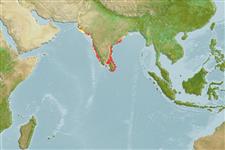Environment: milieu / climate zone / depth range / distribution range
Ecologie
marien; brak water; diepte 0 - 50 m (Ref. 188). Tropical; 26°N - 5°N, 63°E - 91°E (Ref. 188)
Indian Ocean: Karachi to Madras and perhaps north to Calcutta. Specimens from the northwestern coasts of Australia may be this species. Almost certainly mistaken in the past for the very similar Ilisha melastoma in Indian waters.
Grootte / Gewicht / Leeftijd
Maturity: Lm ? range ? - ? cm
Max length : 18.0 cm SL mannelijk / geslacht onbekend; (Ref. 188)
Dorsale stekels (totaal): 0; Anale stekels 0; Anale zachte stralen: 40 - 47. Belly with usually 18 to 21 - 7 to 9, total 26 to 29 scutes. Eye large, lower jaw projecting. Dorsal fin origin a little before midpoint of body; anal fin origin below final dorsal fin ray bases. Vertical striae on scale with a distinct gap across center of scale. Flanks with faint dark band. Swim bladder with two tubes passing back in the muscles on either side of haemal spines.
Occurs in coastal waters, but probably also enters estuaries. Caught with Ilisha melastoma (Ref. 171). More data needed.
Levenscyclus en paargedrag
Maturiteit | Voortplanting | Paaien | Eieren | Fecunditeit | Larven
Whitehead, P.J.P., 1985. FAO Species Catalogue. Vol. 7. Clupeoid fishes of the world (suborder Clupeoidei). An annotated and illustrated catalogue of the herrings, sardines, pilchards, sprats, shads, anchovies and wolf-herrings. FAO Fish. Synop. 125(7/1):1-303. Rome: FAO. (Ref. 188)
Status op de Rode Lijst van het IUCN (Ref. 130435)
Gevaar voor de mens
Harmless
Gebruik door de mens
Visserij: visserij voor eigen gebruik
Meer informatie
Lokale namenSynoniemenMetabolismePredatorenEcotoxicologieVoortplantingMaturiteitPaaienPaaiaggregatiesFecunditeitEierenOntwikkeling van de eieren
ReferentiesAquacultuurAquacultuurprofielKweeklijnenGeneticaElectrophoresesErfelijkheidZiektesVerwerkingNutrientsMassaconversie
Tools
Speciale rapporten
Download XML
Internetbronnen
Estimates based on models
Preferred temperature (Ref.
123201): 27 - 28.6, mean 27.8 °C (based on 48 cells).
Fylogenetische diversiteitsindex (Ref.
82804): PD
50 = 0.5000 [Uniqueness, from 0.5 = low to 2.0 = high].
Bayesian length-weight: a=0.00871 (0.00397 - 0.01910), b=3.04 (2.87 - 3.21), in cm total length, based on LWR estimates for this Genus-body shape (Ref.
93245).
Trofisch niveau (Ref.
69278): 3.4 ±0.5 se; based on size and trophs of closest relatives
Weerstandsvermogen (Ref.
120179): Hoog, minimale populatieverdubbelingstijd minder dan 15 maanden (Preliminary K or Fecundity.).
Fishing Vulnerability (Ref.
59153): Low vulnerability (12 of 100).
